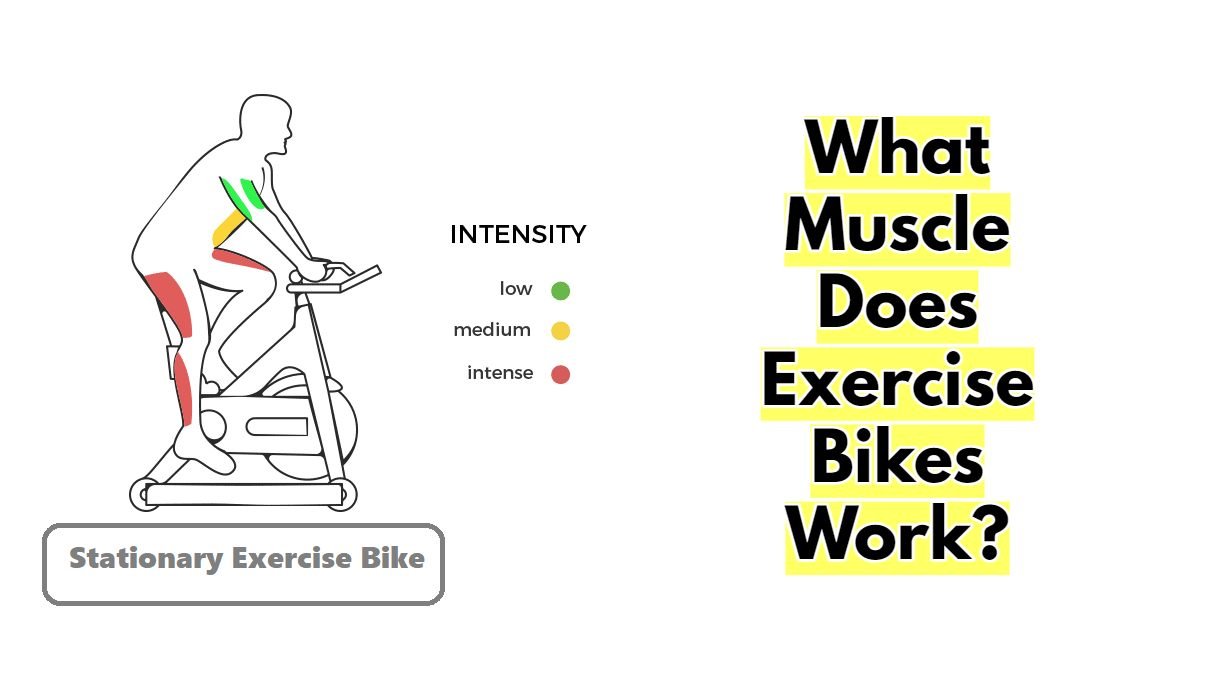Stationary exercise bikes are a highly effective way to improve overall health and fitness by burning calories, increasing muscle strength, and providing an aerobic workout with minimal strain on the joints. Different workout plans tailored to individual goals can be used to maximize results.

Training on a exercise bike is a great way to work the lower body muscles, namely the calves, thighs and glutes, as well as offering cardiovascular benefits. The arms are also working to a lesser extent.
Lets take a closer look!
What Muscles Does a Stationary Exercise Bike Work Out?
Using a stationary exercise bike can provide a full body workout that targets all key muscle groups.
This bike customizes your ride according to your current cycling fitness level, making it an effective way to strengthen and develop both lower and upper muscle groups like the thighs, calves, arms, core, and more.
Quads and Hamstrings
The quads and hamstrings are two distinct muscle groups in the front and back of the thighs, respectively.
Both muscle groups are worked when cycling on a stationary bike, with the quads used as knee extensors and the hamstrings flexing the knee. The intensity of activity determines how much toning is achieved.
Glutes
The gluteal muscles, commonly referred to as the buttocks, are engaged when pedaling on a bicycle. These muscles work in tandem with the hips to power the cycling motion, thereby toning and strengthening the buttocks of varying sizes.
Calves
The triceps sural muscles, commonly known as calf muscles, are located at the back of the leg and play an important role in cycling. The primary calf muscle used for pedaling is the gastrocnemius, which helps with lifting the heel and extending the foot.
Hip Flexors
The muscle group that surrounds and supports the ball-and-socket joint in the legs is vital for movement, with cycling being an effective way to both tone and stretch these flexors, as well as aiding movement of the leg and knee up towards the torso and bending of the upper body towards the hip.
Upper Body
Exercise bikes can provide a full body workout by targeting both the lower and upper body muscles. When you pedal with high resistance while standing up, your arms, lower back, abs, and shoulder muscles all receive a workout.
As you change positions while cycling, the shift in body positioning further engages your upper body muscles groups, helping to tone and strengthen them.
Abdominal Muscles
Cycling is an effective exercise for toning the muscles in the legs, but it also works out other muscles, such as the abs.
While cycling alone may not result in rock-hard abs, it does help to strengthen the core which can provide strength and stability for performing all movements associated with cycling.
Back
Cycling is beneficial for strengthening and toning back muscles, which in turn leads to increased stability of the spine, providing a more comfortable and stable ride.
Biceps and Triceps
Cycling is a great way to work your biceps and triceps, which are located in the front and back of your arms.
Intensifying your cycling and riding out of the saddle will allow you to really target these muscles by tightening your grip.
What Parts Of The Body Does A Stationary Bike Work? See this Video
What are the benefits of a stationary bike workout?

1. Boosts cardio fitness
Cycling is an effective way to boost your cardiovascular fitness, as it strengthens your heart, lungs and muscles.
It can also lead to improved memory and brain functioning, lower blood pressure, better sleep, improved blood sugar levels, a stronger immune system, better mood, lower stress levels and more energy.
2. Can help with weight loss
Indoor cycling can be an effective exercise for those looking to burn a significant amount of calories in a relatively short amount of time.
It is estimated that one can burn more than 600 calories an hour while cycling, which makes it crucial to incorporate into any weight loss plan, as burning more calories than consumed is the key to successful weight loss.
3. Burns body fat
Exercising at a high intensity is beneficial for burning calories and developing strength, leading to potential weight loss.
4. Provides a low-impact workout
A stationary bike workout is a beneficial exercise for people with joint issues or injuries due to its low-impact nature.
It provides an effective workout without putting too much stress on the ankles, knees, hips and other joints as compared to running, jogging or jumping.
5. Strengthens legs and lower body muscles
Stationary biking is an effective way to build strength in the legs, core, back and glutes, as well as the upper body muscles such as the biceps, triceps and shoulders. The use of higher resistance will allow for increased muscle strengthening.
6. Allows for interval training
Interval training is an effective way to increase fitness levels and burn calories quickly.
It involves alternating short bursts of intense exercise with longer periods of low intensity activity.
Stationary bikes are ideal for this type of training as they offer resistance levels that can be adjusted to different intensities.
7. Safer than road cycling
Indoor cycling is a great way to exercise without the danger of inattentive drivers, hazardous road surfaces, and poor visibility; furthermore, exercising indoors provides safety and comfort regardless of external conditions.
Workout plans for different fitness levels

For Beginners
For those just starting to build their fitness, a gradual approach is recommended. Begin with a 25- to 35-minute workout and progress from there.
This could include cycling at low intensity for 5-10 minutes, followed by medium intensity for 5 minutes, then high intensity for 1-2 minutes, repeating this pattern until the end of the workout.
For weight loss
This type of workout helps to burn calories and body fat, making it a suitable addition to any weight loss plan. It also provides the opportunity for quickly changing resistance levels.
A sample plan consists of a warm-up period at low intensity, followed by medium intensity for 3-5 minutes, alternating between high and medium intensity for 20-30 minutes, and then finishing with a cool down at low intensity.
For interval training
Interval training is a great way to build strength and stamina. This involves starting with a low intensity for 10 minutes, then increasing the intensity for 2 minutes at a time, followed by a cooldown of 5-10 minutes. Gradually increasing intervals by one minute at a time will improve performance over time.
Types of stationary bikes
There are three main types of stationary bikes: upright, recumbent, and dual-action. Each one provides different advantages depending on the user’s fitness level, joint health, and desired workout goals.
As such, individuals can choose to focus on a single bike or incorporate all three into their workout routine for added variety.
Upright bike
The upright bike is a popular stationary bike option which provides users with an effective cardio and muscle strengthening workout.
It can be used while either standing or seated, however the upright position can put strain on hands and wrists and the small seat size may cause discomfort during longer workouts.
Recumbent bike
A recumbent stationary bike is highly recommended for those with mobility issues, joint problems or back pain.
It allows users to ride in a comfortable reclined position, reducing fatigue and muscle soreness while providing support to the body. It is also a safer option for older adults or those new to exercise.
Dual-action bike
This text discusses a dual-action bike, which is distinct from a regular road bicycle due to its handlebars that move both backward and forward in order to target the upper body muscles.
As such, riders can benefit from a full-body workout as they pedal.
Other types of bikes
Indoor cycle bikes are the most popular type of indoor cycling classes, and they are similar to an upright bike but with an elevated seat. These bikes feature a weighted flywheel on the front which creates adjustable resistance to simulate different terrains or wind conditions.
An alternative is fan or air bikes, where resistance is generated through pedaling faster, which makes them generally less expensive than other stationary bicycles.
What muscles does indoor cycling work vs. outdoor bike riding?
Indoor and outdoor biking both offer full-body exercise benefits; however, the type of bike affects how much certain muscles are worked.
Outdoor bikes work the core and upper body more than stationary bikes, while indoor cycling classes that incorporate additional movements will target the arm muscles.
Furthermore, any class that involves hands-free riding or dance-like shimmies and shakes requires extra core activation to maintain balance and stability.
Safety tips
Stationary biking is a safer alternative to outdoor biking, but it still requires safety precautions.
It is essential to use the correct form when cycling and not overexert yourself, particularly during group classes.
Furthermore, if you experience any pain or have issues related to your balance, blood pressure or heart health, it is advisable to consult with a doctor before embarking on a stationary bike workout.
FAQ’s – What Muscle Does Exercise Bikes Work?
What are the best cross-training workouts for biking?
Biking alone can possibly help you meet your strength goals, but Sebastian recommends adding resistance training to maximize longevity on the bike, reduce injury risk and fight against muscle imbalances.
This should include movements across all planes of motion, such as squats, deadlifts and planks.
Resistance training will also make you a better rider by helping activate muscles more easily while riding.
Consulting a fitness professional is recommended to find the perfect program for individual fitness levels, training age and goals.
Ultimately, biking is beneficial both mentally and physically.
Recumbent vs stationary bikes: what muscles do they work?
Both upright and recumbent exercise bikes provide a low-impact form of exercise, which is beneficial for the gluteal muscles, rectus femoris, hamstrings, gastrocnemius and soleus.
A study has shown that the recumbent bike works two muscles harder than the upright bike; however, cyclists have been found to have lower bone mineral density than those who don’t cycle.
It is important to incorporate other forms of exercise in order to build bone strength.
How Long Does It Take To Build Muscle on a Stationary Bike?
With a consistent training routine and dedication, one can expect to see results in their lower body muscle mass after four to six weeks of exercise.
After two to three months, a noticeable difference in physique should be visible as the body fat has reduced and the muscle mass has increased.
How Long Should You Ride a Stationary Bike?
Stationary bike workouts can vary in duration, with beginners recommended to start with 10-20 minutes and gradually work up to 30 minutes or more. This will depend on an individual’s fitness and health goals.
Are Exercise Bikes Good for Belly Fat?
Exercise bikes are an effective way to reduce belly fat when incorporated into a balanced diet.
According to Harvard Health Publishing, a 30-minute moderate-intensity stationary bike ride can burn between 210 and 292 calories depending on the individual’s weight.
Similarly, vigorous stationary biking for 30 minutes can burn up to 441 calories. Additional calorie burning occurs depending on the rider’s weight.
Are exercise bikes good for a healthy lifestyle?
Eating a balanced diet is essential for a healthy lifestyle, and increasing one’s protein intake can help improve overall health and fitness.
Protein is necessary for muscle growth and repair, aiding in the process of restoring muscle fibers after exercise. Regular exercise can also improve heart health, lung capacity, and immunity.
The bottom line
Riding a stationary exercise bike can bring numerous physical benefits, from improved cardiovascular health to strengthen leg muscles and core and back engagement.
Furthermore, it is a low-impact workout that is safe for the joints. It is essential to understand which muscles are used during this type of exercise in order to guarantee correct form and engage them properly.
To stay up-to-date with the latest stationary bikes and other fitness tips, readers should explore more resources.